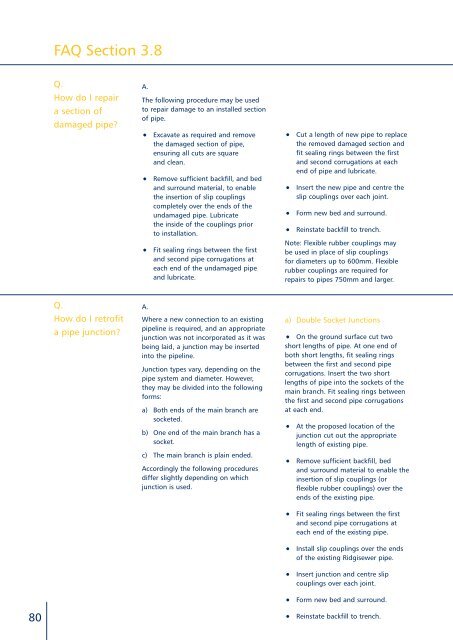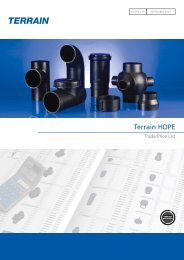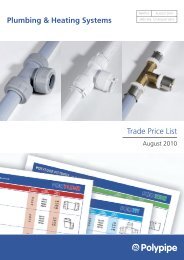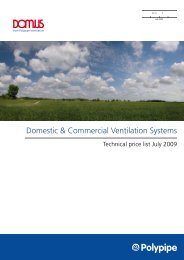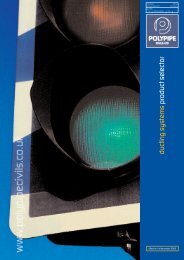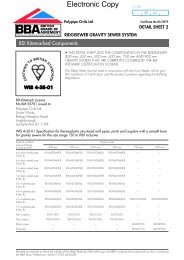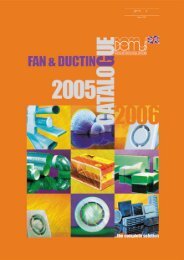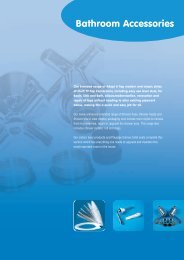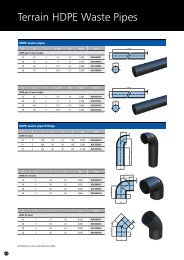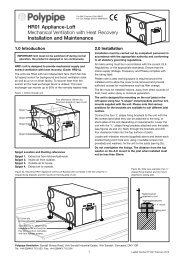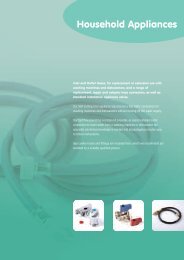advanced drainage system - Polypipe
advanced drainage system - Polypipe
advanced drainage system - Polypipe
You also want an ePaper? Increase the reach of your titles
YUMPU automatically turns print PDFs into web optimized ePapers that Google loves.
FAQ Section 3.8<br />
Q.<br />
How do I repair<br />
a section of<br />
damaged pipe?<br />
A.<br />
The following procedure may be used<br />
to repair damage to an installed section<br />
of pipe.<br />
• Excavate as required and remove<br />
the damaged section of pipe,<br />
ensuring all cuts are square<br />
and clean.<br />
• Remove sufficient backfill, and bed<br />
and surround material, to enable<br />
the insertion of slip couplings<br />
completely over the ends of the<br />
undamaged pipe. Lubricate<br />
the inside of the couplings prior<br />
to installation.<br />
• Fit sealing rings between the first<br />
and second pipe corrugations at<br />
each end of the undamaged pipe<br />
and lubricate.<br />
• Cut a length of new pipe to replace<br />
the removed damaged section and<br />
fit sealing rings between the first<br />
and second corrugations at each<br />
end of pipe and lubricate.<br />
• Insert the new pipe and centre the<br />
slip couplings over each joint.<br />
• Form new bed and surround.<br />
• Reinstate backfill to trench.<br />
Note: Flexible rubber couplings may<br />
be used in place of slip couplings<br />
for diameters up to 600mm. Flexible<br />
rubber couplings are required for<br />
repairs to pipes 750mm and larger.<br />
Q.<br />
How do I retrofit<br />
a pipe junction?<br />
A.<br />
Where a new connection to an existing<br />
pipeline is required, and an appropriate<br />
junction was not incorporated as it was<br />
being laid, a junction may be inserted<br />
into the pipeline.<br />
Junction types vary, depending on the<br />
pipe <strong>system</strong> and diameter. However,<br />
they may be divided into the following<br />
forms:<br />
a) Both ends of the main branch are<br />
socketed.<br />
b) One end of the main branch has a<br />
socket.<br />
c) The main branch is plain ended.<br />
Accordingly the following procedures<br />
differ slightly depending on which<br />
junction is used.<br />
a) Double Socket Junctions<br />
• On the ground surface cut two<br />
short lengths of pipe. At one end of<br />
both short lengths, fit sealing rings<br />
between the first and second pipe<br />
corrugations. Insert the two short<br />
lengths of pipe into the sockets of the<br />
main branch. Fit sealing rings between<br />
the first and second pipe corrugations<br />
at each end.<br />
• At the proposed location of the<br />
junction cut out the appropriate<br />
length of existing pipe.<br />
• Remove sufficient backfill, bed<br />
and surround material to enable the<br />
insertion of slip couplings (or<br />
flexible rubber couplings) over the<br />
ends of the existing pipe.<br />
• Fit sealing rings between the first<br />
and second pipe corrugations at<br />
each end of the existing pipe.<br />
• Install slip couplings over the ends<br />
of the existing Ridgisewer pipe.<br />
• Insert junction and centre slip<br />
couplings over each joint.<br />
80<br />
• Form new bed and surround.<br />
• Reinstate backfill to trench.


